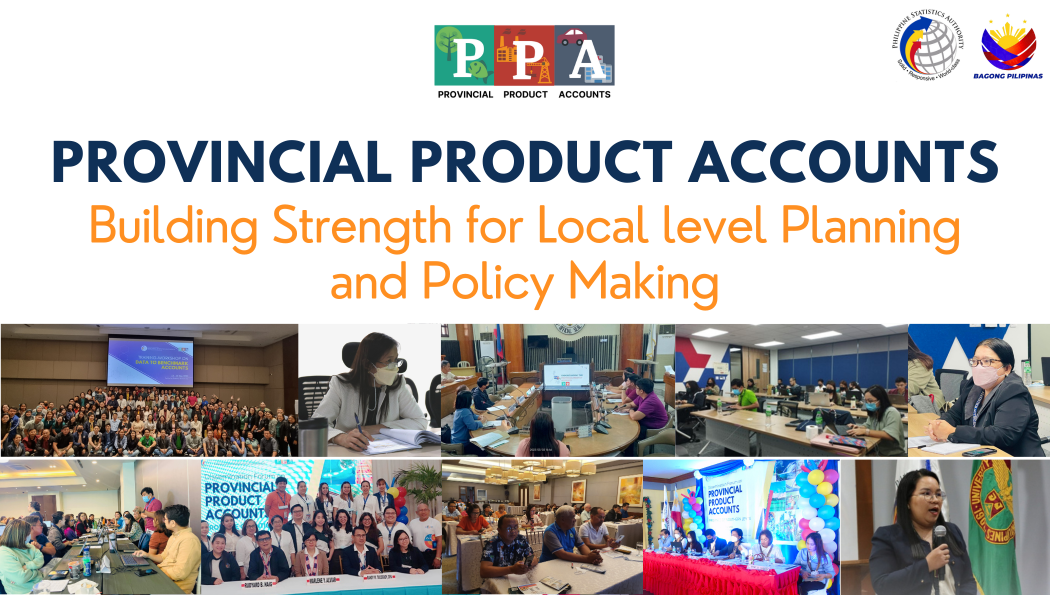Philippine Statistics Authority (PSA)-Bohol is set to have a second round of Dissemination Forum on Provincial Product Accounts (PPA) on 01 December 2022 (Thursday), 1:00 P.M. at Bohol Tropics Resort, Tagbilaran City and virtual platform through Zoom.
The PSA through Republic Act No. 10625 or The Philippine Statistical Act of 2013, is tasked to compile and maintain macroeconomic accounts and indicators, at the national and subnational level. At the provincial level, PPA is now an annual undertaking of our agency to present a comprehensive picture of the provincial economies at a given time.
Ms. Jessamyn Anne C. Alcazaren, Chief Statistical Specialist of PSA-Bohol; Arch. Neil Andrew U. Menjares, OIC Chief, Development Research Division of the National Economic and Development Authority (NEDA) VII; and Dr. Ivy Corazaon A. Mangaya-ay, Vice President of Research, Innovation, and Extension of Bohol Island State University (BISU) are the discussants for this year’s PPA Dissemination Forum.
Highlights of the 2021 PPA Dissemination Forum will also be tweeted live all throughout the duration through Twitter account
@psabohol and will be live-streamed on PSA-Bohol’s official Facebook page
/psabohol.
 Philippine Statistics Authority (PSA)-Bohol is set to have a second round of Dissemination Forum on Provincial Product Accounts (PPA) on 01 December 2022 (Thursday), 1:00 P.M. at Bohol Tropics Resort, Tagbilaran City and virtual platform through Zoom.The PSA through Republic Act No. 10625 or The Philippine Statistical Act of 2013, is tasked to compile and maintain macroeconomic accounts and indicators, at the national and subnational level. At the provincial level, PPA is now an annual undertaking of our agency to present a comprehensive picture of the provincial economies at a given time.Ms. Jessamyn Anne C. Alcazaren, Chief Statistical Specialist of PSA-Bohol; Arch. Neil Andrew U. Menjares, OIC Chief, Development Research Division of the National Economic and Development Authority (NEDA) VII; and Dr. Ivy Corazaon A. Mangaya-ay, Vice President of Research, Innovation, and Extension of Bohol Island State University (BISU) are the discussants for this year’s PPA Dissemination Forum.Highlights of the 2021 PPA Dissemination Forum will also be tweeted live all throughout the duration through Twitter account @psabohol and will be live-streamed on PSA-Bohol’s official Facebook page /psabohol.(SGD.) JESSAMYN ANNE C. ALCAZARENChief Statistical Specialist
Philippine Statistics Authority (PSA)-Bohol is set to have a second round of Dissemination Forum on Provincial Product Accounts (PPA) on 01 December 2022 (Thursday), 1:00 P.M. at Bohol Tropics Resort, Tagbilaran City and virtual platform through Zoom.The PSA through Republic Act No. 10625 or The Philippine Statistical Act of 2013, is tasked to compile and maintain macroeconomic accounts and indicators, at the national and subnational level. At the provincial level, PPA is now an annual undertaking of our agency to present a comprehensive picture of the provincial economies at a given time.Ms. Jessamyn Anne C. Alcazaren, Chief Statistical Specialist of PSA-Bohol; Arch. Neil Andrew U. Menjares, OIC Chief, Development Research Division of the National Economic and Development Authority (NEDA) VII; and Dr. Ivy Corazaon A. Mangaya-ay, Vice President of Research, Innovation, and Extension of Bohol Island State University (BISU) are the discussants for this year’s PPA Dissemination Forum.Highlights of the 2021 PPA Dissemination Forum will also be tweeted live all throughout the duration through Twitter account @psabohol and will be live-streamed on PSA-Bohol’s official Facebook page /psabohol.(SGD.) JESSAMYN ANNE C. ALCAZARENChief Statistical Specialist 2022-PR12-013.pdf
2022-PR12-013.pdf




